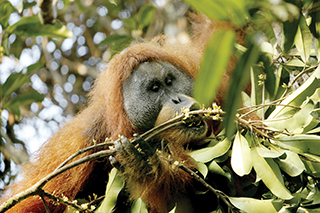New orang utan species in Sumatra
Published on: Friday, November 03, 2017

Kota Kinabalu: An international research team has discovered a new orangutan species in North Sumatra. And with no more than 800 individuals, the new species is now considered the most endangered species of great ape on the planet.Pongo tapanuliensis, otherwise known as the Tapanuli orangutan, was found in the three Tapanuli districts of North Sumatra after close analysis of the ape inhabitants of the Batang Toru Ecosystem.
ADVERTISEMENT
The discovery was made through collaborative research that included researchers from the School of Biosciences at Cardiff University in UK.The international team made up from the Sumatran Orangutan Conservation Programme, Indonesian authorities, the Australian National University, Cardiff University and many other institutions, and led by Prof. Michael Krützen at University of Zürich, determined the unique genetic differences of the apes by completing the largest genomic study of wild orangutans in history."When we realized that Batang Toru orangutans are morphologically different from all other orangutans, the pieces of the puzzle fell into place. The oldest evolutionary line in the genus Pongo is actually found in Batang Toru orangutans, which appear to be direct descendants of the first Sumatran population in the Sunda archipelago," he explained.Computer modelling reconstructed the population history of the three orangutan species, reveals that the Batang Toru apes have been isolated for 10,000 to 20,000 years.
ADVERTISEMENT
Despite thousands of years of research, scientists are still uncovering new species that inhabit our planet. Benoit Goossens, Reader at Cardiff University and Director of Danau Girang Field Centre in Sabah, said: "The Batang Toru populations of orangutans in Sumatra were only rediscovered fairly recently in 1997.
ADVERTISEMENT
However, it wasn't until 2013 that the researchers received the skeleton of an adult male orangutan that was killed during conflict, and we realised that there were significant physical and genetic differences in these apes."He said by comparing the skull to other orangutans, it was clear that this skull showed dramatic differences, suggesting that the Batang Toru population was potentially unique."It's exciting to describe a new great ape species in the 21st century, however with such low numbers of the Batang Toru orangutans, it is vital that we now work to protect them. Mining, hunting, deforestation and human encroachment all risk the lives of these great apes. It is crucial that we work to conserve the forest, because if we do not take the steps needed to protect the Tapanuli orangutans, we could see their discovery and extinction within our lifetime," added Goossens.Stay up-to-date by following Daily Express’s Telegram channel.
Daily Express Malaysia




